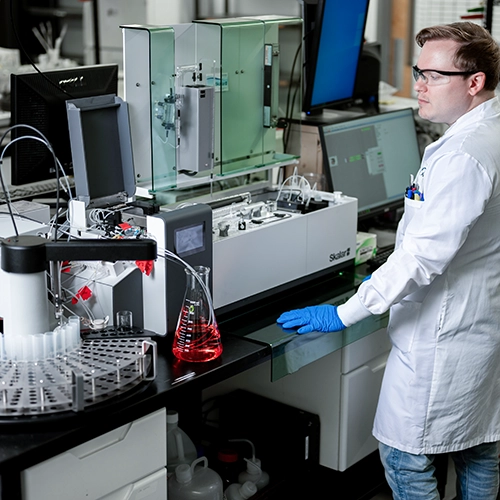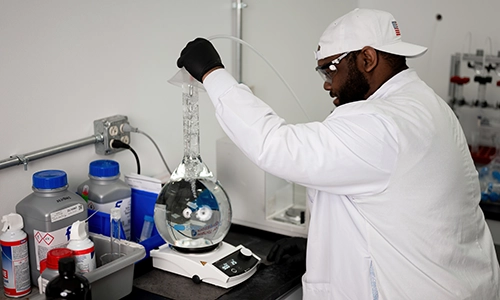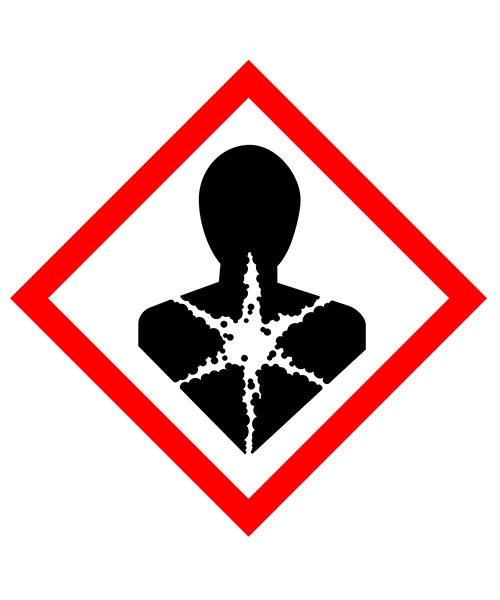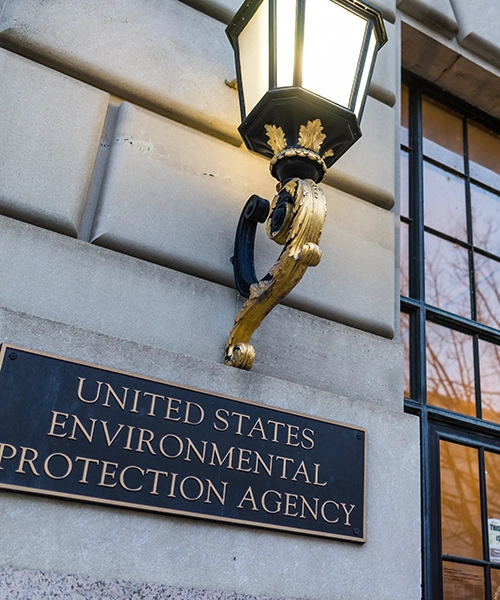Your Trusted Partner For PCB Testing And Analysis
Pace® understands the complex issues in setting up, managing, and working with a PCB site/program. Our experienced PCB project managers can help you select the best, most affordable PCB analysis options for your project requirements. In addition to traditional PCB analysis for PCB Aroclors, our state-of-the-art facilities offer:
- Dual-column analysis on every PCB detection as a standard operating procedure
- Regulatory and analytical expertise in dealing with PCBs
- Congener-specific and specialty Aroclor analyses, including high-resolution mass spectrometry
- Ultra-trace analysis of specific congeners

What Are Polychlorinated Biphenyls (PCBs)?
Polychlorinated biphenyls, commonly known as PCBs, are synthetic organic compounds comprised of carbon, hydrogen, and chlorine atoms. The PCB molecule consists of two connected benzene rings and chlorine atoms that can attach to any or all of 10 different positions, allowing for 209 unique congeners and 10 unique homologs.
PCB congeners with high chlorine content generally have high octanol-water partition coefficients, making them commonly present in organic materials such as soils and sediments. Due to their low water solubility and vapor pressure, PCBs divide between the solid and aquatic phases, leading to contamination across various compartments.
Some commercial PCB mixtures are known in the U.S. by their industrial trade name, Aroclor®, trademarked by the Monsanto Chemical Corporation. Aroclors are not a single PCB congener but rather a complex mixture of multiple congeners.
What Are Dioxin-like Polychlorinated Biphenyls?
PCBs consist of 209 congeners that differ in the number and position of chlorine atoms on the biphenyl and exhibit different toxic properties. Twelve of these congeners are referred to as dioxin-like PCBs (dl-PCBs) as they have a similar structure to dioxins and the same toxic effects. Those without this similarity to dioxins are referred to as non-dioxin-like PCBs (ndl-PCBs).


How Do PCBs Persist In The Environment And Bioaccumulate In People?
Although banned in the U.S. in 1979, PCBs were commonly used in a variety of industrial and commercial applications and products, such as electrical and hydraulic equipment, paint, caulk, plastics, rubber products, pigments, and dyes. Their durability and hydrophobic and lipophilic properties made them useful but also environmentally persistent, allowing them to cycle through air, soil, and water and eventually accumulate in plant, animal, and human tissues.
PCBs can still be released into the environment through poorly maintained hazardous waste sites, illegal or improper dumping of wastes that may contain PCBs, such as old transformer fluids, or leaks or releases from these transformers. Disposal of consumer products, especially those manufactured before 1979, into municipal landfills can also contribute to environmental contamination as can the burning of wastes containing PCBs in municipal and industrial incinerators.
How Are Humans Exposed To PCBs?
PCBs are fat-soluble substances that humans are exposed to through ingesting animal fats, inhalation, or dermal contact. More is becoming known about the toxic effects of PCBs, so despite the decline in PCBs in the environment, they remain an environmental and public health concern. Exposure to PCBs suppresses the immune system. Dioxin-like congeners have been shown to be tumor promoters that can enhance the effects of other carcinogenic substances. PCBs can alter thyroid and reproductive function in both men and women and increase the risk of cardiovascular and liver disease and diabetes.
In addition, PCB exposure, especially during fetal stages and childhood, may reduce IQ and alter behavior. Pregnant women exposed to PCBs have an elevated chance of giving birth to low birth-weight infants with lifelong health risks.

On-demand Webinar
The Lingering Legacy of PCB Air Contamination; Challenges and Solutions
Polychlorinated-biphenyls (PCBs) were introduced in the late 1920s and used until the 1970s when they were banned in most countries due to evidence of environmental build-up and possible adverse health effects. Most people think that exposure to PCBs comes from eating contaminated fish and other animal fats. That is true.
How Are PCBs Regulated?
Many U.S. Environmental Protection Agency (EPA) and state programs are addressing PCBs in the environment. Here are some of the primary programs involved:

OSHA sets and enforces protective workplace safety and health standards and has promulgated regulations that establish permissible exposure limits (PEL) for air pollutants in the workplace. These enforceable standards consider dermal absorption and inhalation exposure and encompass all physical forms of PCB compounds, including aerosols, vapor, mist, sprays, and PCB-laden dust particles.
NIOSH, part of the Centers for Disease Control and Prevention (CDC) in the U.S. Department of Health and Human Services, looks at chronic on-the-job health issues. NIOSH has issued a PCB-exposure advisory recommendation of a 10-hour time-weighted average for workers of 1.0 micrograms per cubic meter (µg/m3).
The FDA protects public health by assuring the safety, efficacy, and security of human and veterinary drugs, biological products, medical devices, our nation's food supply, cosmetics, and products that emit radiation. The FDA mandates tolerances of 0.2-3.0 ppm of PCBs for all foods, with a tolerance level in fish of 2 ppm. FDA also limits PCBs in paper food-packaging materials to 10 ppm.
TSCA authorizes the EPA to regulate and screen all chemicals produced or imported into the U.S. to prevent unreasonable health and environmental risks. TSCA regulations prescribe specific SW-846 extraction methods for analyzing PCBs in a sample.
RCRA is a federal program regulating municipal and hazardous waste disposal. Although PCBs are exempt from RCRA regulations (40 CFR 261.8), state hazardous waste regulatory programs authorized by the EPA may identify PCBs as hazardous wastes.
Numerous states across the U.S. have state-specific limits on PCBs in soil, air, and water. Check with the appropriate regulatory body in the state you are working in to ascertain exactly what these regulatory criteria are.
Examples Of PCB Sources
Manufacturing facilities, including chemical and pesticide factories, pulp and paper mills, and electric power generation plants, have a high likelihood of PCBs in their wastewater effluent. PCB contamination can also stem from equipment leaks and condensation around vacuum pumps, cooling towers, and natural gas pipelines.
Electrical equipment, joint caulking, oil & grease insulated cable, flame-retardant surface coatings, and waterproofing can all be sources of PCBs.
Municipal and industrial solid waste landfills may contain waste materials and soils from remediation sites that contain PCBs. Leachate from these sites may contain PCBs as well.
PCBs can wind up in wastewater sludge and biosolids from a variety of sources: atmospheric deposition, stormwater runoff, leaks and spills, leaching from coatings and plastics containing PCBs, PCBs in food and human waste, and more.
Some fluorescent light ballasts used capacitors that contained PCBs. Additionally, a type of asphaltic resin (potting material) that contained PCBs was sometimes used as insulation in ballasts.
PCBs were commonly used in polyvinyl chloride plastic, neoprene, chlorinated rubbers, laminating adhesives, sealants and caulking, joint compounds (concrete), etc.
Nationally Recognized Leader In PCB Testing
Having experience and expertise in PCB analysis can make all the difference. The largest American-owned lab, Pace® understands the challenges posed by PCB contamination, and we are committed to providing accurate and reliable testing services. The experts at Pace® have the knowledge and experience to assist you in identifying the most appropriate and cost-effective sampling plan for your project.
Let us lend a hand!
Additional Resources
Need to find a lab that can handle your unique requirements?
Contact us directly or download our list of environmental certifications across our network.